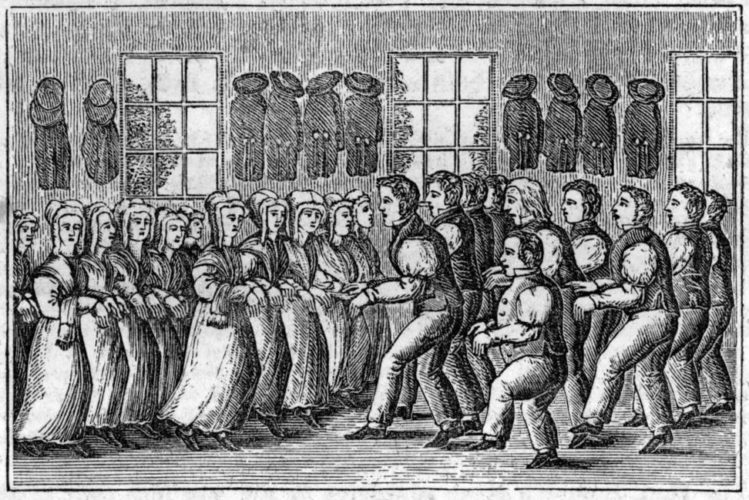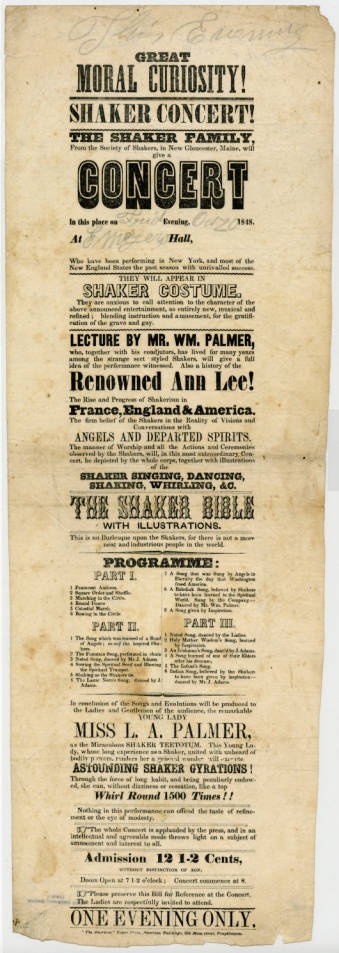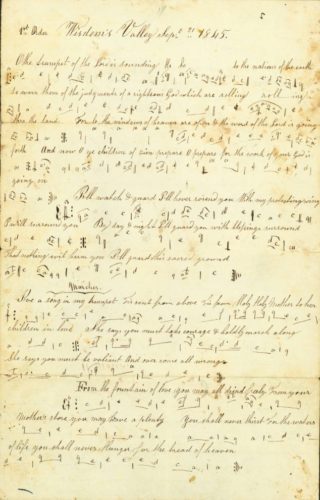A Great Moral Curiosity!


On today’s date, October 20th, in 1848, a Shaker Family Concert took place in Fairfield County, Ohio, that promised quite the spectacle. As seen in the program at right, the event that took place at E. Meyers Hall featured representatives from the Society of Shakers of New Gloucester, Maine. They appeared in “Shaker Costume,” and demonstrated the group’s traditional practices of “singing, dancing, shaking, whirling, &c.”
In addition to a lecture covering the rise of Shakerism, the beliefs of Shakers and a history of their founder, Ann Lee, the performance also offered a display of the Shaker Bible, and a program of music and dance sharing traditional Shaker hymns, including those “learned in the Spritual World” and “Sung by Angels.” The crowning attraction was the “astounding Shaker gyrations” of Miss L. A. Palmer, who could, “through the force of long habit, and being peculiarly endowed, […] without dizziness or cessation, like a top Whirl Round 1500 Times!” Attendees were reassured that the full program was of the utmost respectability, with good reviews from the press, and all ages were encouraged to attend.
The Shakers, also known by their official name of the United Society of Believers in Christ’s Second Coming, are a religious group that originated in Great Britain around 1750, after their founders broke away from the Society of Friends, or Quakers. They were originally known, somewhat derisively, as “Shaking Quakers” because of the highly physical and ecstatic movements that characterized the religious fervor of their worship services.
Shakers arrived in America during the 1770s, led by “Mother” Ann Lee, who had received a vision of the progress that Shakers would make in the new country; they settled largely in New England, but began moving west and reached Ohio in 1805. Several communities were established in the state, with the most successful ones at Lebanon and North Union (modern-day Shaker Heights). By 1846, more than 400 Shakers called Lebanon home, and North Union reached its peak of about 300 settlers around 1850.

Shaker communities in Ohio were typical of the sect’s self-reliant settlements, where members made industrious livings from their orchards, livestock, and other farming activities, as well as from their furniture-making. Shakers believed in communal ownership of property, meaning entire communities held all property in common. In accordance with a dualist view of God as both male and female, they also believed that men and women were equals and demonstrated this through the shared authority of both genders in church and civic leadership.
Adherents also opposed marriage and were required to be celibate, so the religion’s continuation and growth relied solely on new converts, including children who were sometimes adopted or indentured to the community. When given the choice to leave as young adults, many raised in the Shaker faith chose to leave for a life of greater freedom, and by the 1860s, the Shakers were in serious decline due to a lack of new members. Ohio’s Shakers had virtually disappeared by 1900, and as numbers declined, many Ohio Shakers moved to Shaker communities in other states.
Today, only a very few people still follow the Shaker religious tradition, and the remaining active Shaker community can be found at Sabbathday Lake in New Gloucester, Maine–the same town from which the 1848 Shakers described above hailed! You can learn more about Ohio’s Shaker history on Ohio Memory, or by exploring the Shaker Historical Museum, White Water Shaker Village, and Ohio’s historical markers around the state.
Thanks to Lily Birkhimer, Digital Projects Coordinator at the Ohio History Connection, for this week’s post!



Leave a Reply
You must be logged in to post a comment.